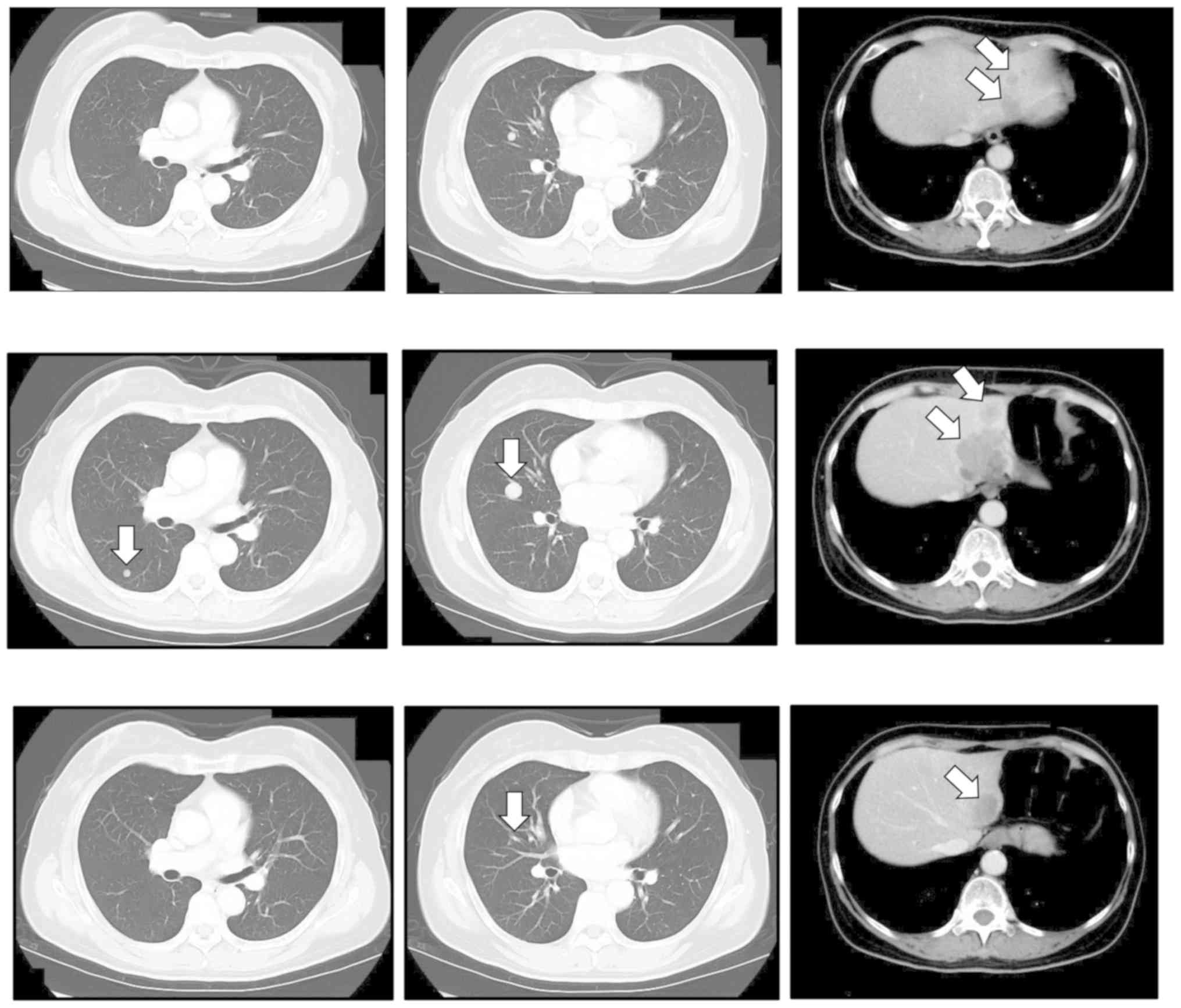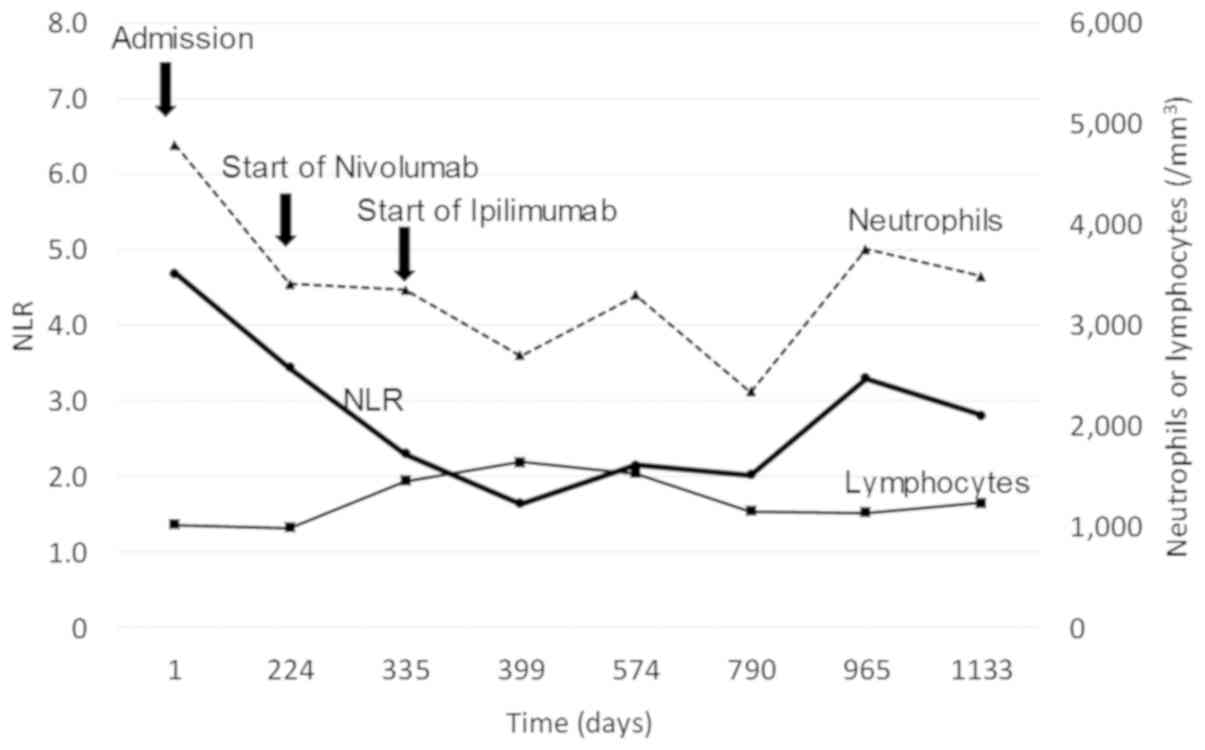|
1
|
Lian B, Cui CL, Zhou L, Song X, Zhang XS,
Wu D, Si L, Chi ZH, Sheng XN, Mao LL, et al: The natural history
and patterns of metastases from mucosal melanoma: An analysis of
706 prospectively-followed patients. Ann Oncol. 28:868–873.
2017.PubMed/NCBI View Article : Google Scholar
|
|
2
|
Furney SJ, Turajlic S, Stamp G, Nohadani
M, Carlisle A, Thomas JM, Hayes A, Strauss D, Gore M, van den Oord
J, et al: Genome sequencing of mucosal melanomas reveals that they
are driven by distinct mechanisms from cutaneous melanoma. J
Pathol. 230:261–269. 2013.PubMed/NCBI View Article : Google Scholar
|
|
3
|
van Schaik PM, Ernst MF, Meijer HA and
Bosscha K: Melanoma of the rectum: A rare entity. World J
Gastroenterol. 14:1633–1635. 2008.PubMed/NCBI View Article : Google Scholar
|
|
4
|
Chang AE, Karnell LH and Menck HR: The
national cancer data base report on cutaneous and noncutaneous
melanoma: A summary of 84,836 cases from the past decade. The
American college of surgeons commission on cancer and the American
cancer society. Cancer. 83:1664–1678. 1998.PubMed/NCBI View Article : Google Scholar
|
|
5
|
Haanen JBAG: Converting cold into hot
tumors by combining immunotherapies. Cell. 170:1055–1056.
2017.PubMed/NCBI View Article : Google Scholar
|
|
6
|
Brady MS, Kavolius JP and Quan SH:
Anorectal melanoma. A 64-year experience at memorial
sloan-kettering cancer center. Dis Colon Rectum. 38:146–151.
1995.PubMed/NCBI View Article : Google Scholar
|
|
7
|
Perez DR, Trakarnsanga A, Shia J, Nash GM,
Temple LK, Paty PB, Guillem JG, Garcia-Aguilar J, Bello D, Ariyan
C, et al: Locoregional lymphadenectomy in the surgical management
of anorectal melanoma. Ann Surg Oncol. 20:2339–2344.
2013.PubMed/NCBI View Article : Google Scholar
|
|
8
|
Hicks CW, Pappou EP, Magruder JT, Gazer B,
Fang S, Wick EC, Gearhart SL, Ahuja N and Efron JE:
Clinicopathologic presentation and natural history of anorectal
melanoma: A case series of 18 patients. JAMA Surg. 149:608–611.
2014.PubMed/NCBI View Article : Google Scholar
|
|
9
|
Hillenbrand A, Barth TF, Henne-Bruns D and
Formentini A: Anorectal amelanotic melanoma. Colorectal Dis.
10:612–615. 2008.PubMed/NCBI View Article : Google Scholar
|
|
10
|
Malaguarnera G, Madeddu R, Catania VE,
Bertino G, Morelli L, Perrotta RE, Drago F, Malaguarnera M and
Latteri S: Anorectal mucosal melanoma. Oncotarget. 9:8785–8800.
2018.PubMed/NCBI View Article : Google Scholar
|
|
11
|
D'Angelo SP, Larkin J, Sosman JA, Lebbé C,
Brady B, Neyns B, Schmidt H, Hassel JC, Hodi FS, Lorigan P, et al:
Efficacy and safety of nivolumab alone or in combination with
ipilimumab in patients with mucosal melanoma: A pooled analysis. J
Clin Oncol. 35:226–235. 2017.PubMed/NCBI View Article : Google Scholar
|
|
12
|
Del Vecchio M, Di Guardo L, Ascierto PA,
Grimaldi AM, Sileni VC, Pigozzo J, Ferraresi V, Nuzzo C, Rinaldi G,
Testori A, et al: Efficacy and safety of ipilimumab 3 mg/kg in
patients with pretreated, metastatic, mucosal melanoma. Eur J
Cancer. 50:121–127. 2014.PubMed/NCBI View Article : Google Scholar
|
|
13
|
Postow MA, Luke JJ, Bluth MJ, Ramaiya N,
Panageas KS, Lawrence DP, Ibrahim N, Flaherty KT, Sullivan RJ, Ott
PA, et al: Ipilimumab for patients with advanced mucosal melanoma.
Oncologist. 18:726–732. 2013.PubMed/NCBI View Article : Google Scholar
|
|
14
|
Büttner R, Longshore JW, López-Ríos F,
Merkelbach-Bruse S, Normanno N, Rouleau E and Penault-Llorca F:
Implementing TMB measurement in clinical practice: Considerations
on assay requirements. ESMO Open. 4(e000442)2019.PubMed/NCBI View Article : Google Scholar
|
|
15
|
Hugo W, Zaretsky JM, Sun L, Song C, Moreno
BH, Hu-Lieskovan S, Berent-Maoz B, Pang J, Chmielowski B, Cherry G,
et al: Genomic and transcriptomic features of response to Anti-PD-1
therapy in metastatic melanoma. Cell. 165:35–44. 2016.PubMed/NCBI View Article : Google Scholar
|
|
16
|
Van Allen EM, Miao D, Schilling B, Shukla
SA, Blank C, Zimmer L, Sucker A, Hillen U, Foppen MHG, Goldinger
SM, et al: Genomic correlates of response to CTLA-4 blockade in
metastatic melanoma. Science. 350:207–211. 2015.PubMed/NCBI View Article : Google Scholar
|
|
17
|
Snyder A, Makarov V, Merghoub T, Yuan J,
Zaretsky JM, Desrichard A, Walsh LA, Postow MA, Wong P, Ho TS, et
al: Genetic basis for clinical response to CTLA-4 blockade in
melanoma. N Engl J Med. 371:2189–2199. 2014.PubMed/NCBI View Article : Google Scholar
|
|
18
|
Johnson DB, Frampton GM, Rioth MJ, Yusko
E, Xu Y, Guo X, Ennis RC, Fabrizio D, Chalmers ZR, Greenbowe J, et
al: Targeted next generation sequencing identifies markers of
response to PD-1 blockade. Cancer Immunol Res. 4:959–967.
2016.PubMed/NCBI View Article : Google Scholar
|
|
19
|
Berger MF, Hodis E, Heffernan TP, Deribe
YL, Lawrence MS, Protopopov A, Ivanova E, Watson IR, Nickerson E,
Ghosh P, et al: Melanoma genome sequencing reveals frequent PREX2
mutations. Nature. 485:502–506. 2012.PubMed/NCBI View Article : Google Scholar
|
|
20
|
Hayward NK, Wilmott JS, Waddell N,
Johansson PA, Field MA, Nones K, Patch AM, Kakavand H, Alexandrov
LB, Burke H, et al: Whole-genome landscapes of major melanoma
subtypes. Nature. 545:175–180. 2017.PubMed/NCBI View Article : Google Scholar
|
|
21
|
Larkin J, Chiarion-Sileni V, Gonzalez R,
Grob JJ, Cowey CL, Lao CD, Schadendorf D, Dummer R, Smylie M,
Rutkowski P, et al: Combined nivolumab and ipilimumab or
monotherapy in untreated melanoma. N Engl J Med. 373:23–34.
2015.PubMed/NCBI View Article : Google Scholar
|
|
22
|
Kaunitz GJ, Cottrell TR, Lilo M, Muthappan
V, Esandrio J, Berry S, Xu H, Ogurtsova A, Anders RA, Fischer AH,
et al: Melanoma subtypes demonstrate distinct PD-L1 expression
profiles. Lab Invest. 97:1063–1071. 2017.PubMed/NCBI View Article : Google Scholar
|
|
23
|
Taube JM, Anders RA, Young GD, Xu H,
Sharma R, McMiller TL, Chen S, Klein AP, Pardoll DM, Topalian SL
and Chen L: Colocalization of inflammatory response with B7-h1
expression in human melanocytic lesions supports an adaptive
resistance mechanism of immune escape. Sci Transl Med.
4(127ra37)2012.PubMed/NCBI View Article : Google Scholar
|
|
24
|
Dodds TJ, Wilmott JS, Jackett LA, Lo SN,
Long GV, Thompson JF and Scolyer RA: Primary anorectal melanoma:
Clinical, immunohistology and DNA analysis of 43 cases. Pathology.
51:39–45. 2019.PubMed/NCBI View Article : Google Scholar
|
|
25
|
Zaragoza J, Caille A, Beneton N, Bens G,
Christiann F, Maillard H and Machet L: High neutrophil to
lymphocyte ratio measured before starting ipilimumab treatment is
associated with reduced overall survival in patients with melanoma.
Br J Dermatol. 174:146–151. 2016.PubMed/NCBI View Article : Google Scholar
|
|
26
|
Cassidy MR, Wolchok RE, Zheng J, Panageas
KS, Wolchok JD, Coit D, Postow MA and Ariyan C: Neutrophil to
lymphocyte ratio is associated with outcome during ipilimumab
treatment. EBioMedicine. 18:56–61. 2017.PubMed/NCBI View Article : Google Scholar
|
|
27
|
Ferrucci PF, Gandini S, Battaglia A,
Alfieri S, Di Giacomo AM, Giannarelli D, Cappellini GC, De Galitiis
F, Marchetti P, Amato G, et al: Baseline neutrophil-to-lymphocyte
ratio is associated with outcome of ipilimumab-treated metastatic
melanoma patients. Br J Cancer. 112:1904–1910. 2015.PubMed/NCBI View Article : Google Scholar
|
|
28
|
Ferrucci PF, Ascierto PA, Pigozzo J, Del
Vecchio M, Maio M, Antonini Cappellini GC, Guidoboni M, Queirolo P,
Savoia P, Mandalà M, et al: Baseline neutrophils and derived
neutrophil-to-lymphocyte ratio: Prognostic relevance in metastatic
melanoma patients receiving ipilimumab. Ann Oncol. 27:732–738.
2016.PubMed/NCBI View Article : Google Scholar
|












